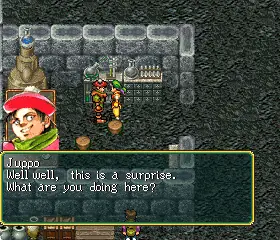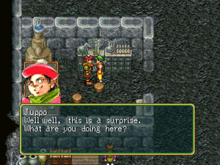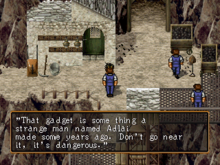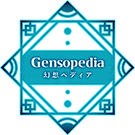More actions
mNo edit summary |
m Text replacement - "Genso Suikoden Genso Shinsho Vol. 9 2002 Summer Issue" to "Genso Suikoden Genso Shinsho Vol.9" |
||
| (4 intermediate revisions by the same user not shown) | |||
| Line 1: | Line 1: | ||
'''Alchemy''' (錬金術, ''Renkinjutsu'') is a philosophical and scientific tradition utilized by several characters of the [[Suikoden series]]. It is the Suikoden equivalent of the scientific method. | {{Custom thumbnail}}'''Alchemy''' (錬金術, ''Renkinjutsu'') is a philosophical and scientific tradition utilized by several characters of the [[Suikoden series]]. It is the Suikoden equivalent of the scientific method. | ||
Most non-[[rune]] based chemical and mechanical developments in the world of Suikoden are considered alchemical to some degree, save for medicine and, apparently, the works of the [[Dwarf|dwarves]]. Alchemy, like much knowledge in the Suikoden world, can be traced back to the [[Sindar]]. | Most non-[[rune]] based chemical and mechanical developments in the world of Suikoden are considered alchemical to some degree, save for medicine and, apparently, the works of the [[Dwarf|dwarves]]. Alchemy, like much knowledge in the Suikoden world, can be traced back to the [[Sindar]]. | ||
==Origins and disciplines== | ==Origins and disciplines== | ||
[[File:Toran Castle basement laboratory.png|thumb|left|220px|During the [[Gate Rune War]], [[Kamandol]] and [[Juppo]] conducted research as part of the [[Toran Liberation Army]].]]Alchemy, as a method of engineering, is said to have originated with the [[Sindar]] engineer [[Borah Atkins]]<ref name="multiple">[[Genso Suikoden Encyclopaedia]] (ISBN 4-575-16297-3), page 318</ref><ref name="multiple3">[[Genso Suikoden Kiwami Encyclopedia]], page 116</ref>. The Sindar were said to have had much in the way of advanced technology and the term alchemy itself was originally used to refer to Doctor Atkins but has since spread to compass most any inventor<ref name="multiple5">[[Genso Suikoden 108 Stars Character Guide]] (ISBN 4-7753-0050-4), page 239</ref><ref name="multiple4">[[Genso Suikoden Genso Shinsho Vol. 9 | [[File:Toran Castle basement laboratory.png|thumb|left|220px|During the [[Gate Rune War]], [[Kamandol]] and [[Juppo]] conducted research as part of the [[Toran Liberation Army]].]]Alchemy, as a method of engineering, is said to have originated with the [[Sindar]] engineer [[Borah Atkins]]<ref name="multiple">[[Genso Suikoden Encyclopaedia]] (ISBN 4-575-16297-3), page 318</ref><ref name="multiple3">[[Genso Suikoden Kiwami Encyclopedia]], page 116</ref>. The Sindar were said to have had much in the way of advanced technology and the term alchemy itself was originally used to refer to Doctor Atkins but has since spread to compass most any inventor<ref name="multiple5">[[Genso Suikoden 108 Stars Character Guide]] (ISBN 4-7753-0050-4), page 239</ref><ref name="multiple4">[[Genso Suikoden Genso Shinsho Vol.9]] (ISBN 4-7753-0088-1), page 56</ref>. Modern alchemy derives mainly from [[Dennis Toller]] and his work, [[Dialogues of Wind and Earth]]<ref name="multiple" /><ref name="multiple3" />. [[Kamandol]]'s [[Engine|machine that works by burning oil]] was the result of Kamandol's extensive research into this tome<ref name="multiple5" />. | ||
Alchemists tend to conduct research individually and independently and as such, their methods and goals can vary wildly<ref name="multiple4" />. Alchemical innovations and offshoots of Dennis Toller's work have been used by [[blacksmith]]s, for both weapon and armor creation, [[trickster]]s, for engineering purposes, as well as the [[Howling Voice Guild]], in the maintaining of their weapons<ref name="multiple2">[[Genso Suikoden I & II Official World Guide Book]] (ISBN 4-471-36033-7), page 47</ref>. [[Mace]] and [[Tessai]], for example, were said to have utilized alchemical innovations in the pursuit of their craft<ref name="multiple4" />. Trickster research in particular is said to have jumped forward quite a bit in recent times<ref name="multiple4" />. | Alchemists tend to conduct research individually and independently and as such, their methods and goals can vary wildly<ref name="multiple4" />. Alchemical innovations and offshoots of Dennis Toller's work have been used by [[blacksmith]]s, for both weapon and armor creation, [[trickster]]s, for engineering purposes, as well as the [[Howling Voice Guild]], in the maintaining of their weapons<ref name="multiple2">[[Genso Suikoden I & II Official World Guide Book]] (ISBN 4-471-36033-7), page 47</ref>. [[Mace]] and [[Tessai]], for example, were said to have utilized alchemical innovations in the pursuit of their craft<ref name="multiple4" />. Trickster research in particular is said to have jumped forward quite a bit in recent times<ref name="multiple4" />. | ||
| Line 20: | Line 20: | ||
<references /> | <references /> | ||
{{ | {{GS00}} {{Short description|Scientfic method of the Suikoden series}} | ||
[[Category: | [[Category: Lore]] | ||
Latest revision as of 10:36, 10 February 2023
 Alchemy (錬金術, Renkinjutsu) is a philosophical and scientific tradition utilized by several characters of the Suikoden series. It is the Suikoden equivalent of the scientific method.
Alchemy (錬金術, Renkinjutsu) is a philosophical and scientific tradition utilized by several characters of the Suikoden series. It is the Suikoden equivalent of the scientific method.
Most non-rune based chemical and mechanical developments in the world of Suikoden are considered alchemical to some degree, save for medicine and, apparently, the works of the dwarves. Alchemy, like much knowledge in the Suikoden world, can be traced back to the Sindar.
Origins and disciplines

Alchemy, as a method of engineering, is said to have originated with the Sindar engineer Borah Atkins[1][2]. The Sindar were said to have had much in the way of advanced technology and the term alchemy itself was originally used to refer to Doctor Atkins but has since spread to compass most any inventor[3][4]. Modern alchemy derives mainly from Dennis Toller and his work, Dialogues of Wind and Earth[1][2]. Kamandol's machine that works by burning oil was the result of Kamandol's extensive research into this tome[3].
Alchemists tend to conduct research individually and independently and as such, their methods and goals can vary wildly[4]. Alchemical innovations and offshoots of Dennis Toller's work have been used by blacksmiths, for both weapon and armor creation, tricksters, for engineering purposes, as well as the Howling Voice Guild, in the maintaining of their weapons[5]. Mace and Tessai, for example, were said to have utilized alchemical innovations in the pursuit of their craft[4]. Trickster research in particular is said to have jumped forward quite a bit in recent times[4].
These four uses; general research, gadgetry, blacksmithing and gunpowder are usually held separate from each other as four different alchemical disciplines[4].
Perception

The name "alchemy" has been attached to the practice out of ignorance by the general population, thinking the practice focuses on attempts to create wealth and riches such as gold[1][2], rather than more practical uses derived from chemistry and engineering. Whereas rune magic is esoteric and subtle, and its effects can vary depending on the type of rune, the bearer, their location, when they use it, etcetera, alchemy attempts to create standardized technology with repeatable, easily replicable results[5].
The two most widely known alchemical innovations are perhaps Kamandol's previous mentioned engine and Sergei's elevator[4]. Adlai's elevator in Tinto City, used for transporting ore, is yet another alchemical creation[4].
While alchemy is considered useful by governments and the like, in the wider world, where rune magic is in frequent use, it is not rated very highly. The greater acceptance of alchemy has stalled as most people see no reason to displace their reliance on runes as they accomplish their needs seemingly well enough[5].
References
- ↑ 1.0 1.1 1.2 Genso Suikoden Encyclopaedia (ISBN 4-575-16297-3), page 318
- ↑ 2.0 2.1 2.2 Genso Suikoden Kiwami Encyclopedia, page 116
- ↑ 3.0 3.1 Genso Suikoden 108 Stars Character Guide (ISBN 4-7753-0050-4), page 239
- ↑ 4.0 4.1 4.2 4.3 4.4 4.5 4.6 Genso Suikoden Genso Shinsho Vol.9 (ISBN 4-7753-0088-1), page 56
- ↑ 5.0 5.1 5.2 Genso Suikoden I & II Official World Guide Book (ISBN 4-471-36033-7), page 47
